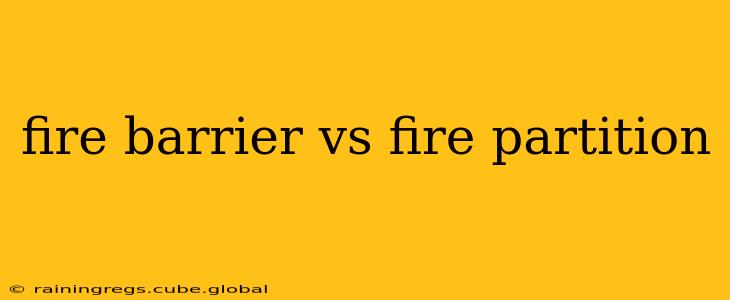Choosing the right fire protection system for your building is crucial for ensuring the safety of occupants and minimizing property damage in the event of a fire. Two common components often used are fire barriers and fire partitions, but understanding their differences is vital. This article clarifies the distinctions between fire barriers and fire partitions, addressing common questions and providing crucial information for architects, builders, and property owners.
What is a Fire Barrier?
A fire barrier is a continuous, fire-resistant vertical or horizontal assembly designed to restrict the spread of fire and smoke within a building. It's a more robust and comprehensive fire protection measure than a fire partition. Fire barriers are typically required for separating different occupancies or for subdividing large buildings into smaller, more manageable fire areas. They are designed to withstand higher temperatures and longer durations of fire exposure than fire partitions. Think of them as more substantial "fire walls" within a structure.
Key Characteristics of Fire Barriers:
- High fire-resistance rating: Typically rated for significantly longer periods (e.g., 2, 3, or even 4 hours) than fire partitions.
- Extensive construction: Often incorporates more robust materials and construction techniques to ensure integrity under intense heat.
- Penetration control: Strict requirements for sealing penetrations (e.g., pipes, conduits) to prevent fire spread.
- Used for larger-scale separation: Frequently employed to separate different parts of a building, such as different occupancy types or distinct fire zones.
What is a Fire Partition?
A fire partition is a fire-resistant assembly that provides a degree of fire protection but with less stringent requirements than a fire barrier. It's primarily designed to limit the spread of fire within a single occupancy, such as separating apartments in a multi-unit dwelling or dividing a large office space into smaller areas. While offering fire protection, they generally have lower fire-resistance ratings and less rigorous construction requirements than fire barriers.
Key Characteristics of Fire Partitions:
- Lower fire-resistance rating: Usually rated for shorter periods (e.g., 1 hour) than fire barriers.
- Simpler construction: Generally constructed using less robust materials and methods than fire barriers.
- Less stringent penetration control: While penetration control is still important, the requirements are typically less strict than those for fire barriers.
- Used for smaller-scale separation: Primarily employed to compartmentalize smaller spaces within a single occupancy.
What is the Difference Between a Fire Barrier and a Fire Partition?
The core difference lies in their intended purpose, construction, and fire-resistance ratings. Fire barriers provide a higher level of fire protection and are used for more significant fire separation, often between different occupancies or major building sections. Fire partitions offer a lesser degree of protection and are employed within a single occupancy to limit the spread of fire within that space. The selection depends on the specific building codes, occupancy type, and the desired level of fire protection.
How are Fire Barriers and Fire Partitions Constructed?
Both fire barriers and fire partitions can be constructed using various materials, including:
- Fire-rated drywall: A common component in both, offering a specific fire resistance rating.
- Concrete: Often used for higher fire-resistance ratings in fire barriers.
- Steel: Utilized in structural elements to maintain integrity during a fire.
- Specialized sealants and firestop materials: Essential for sealing penetrations and ensuring the integrity of the assembly.
The specific construction methods and materials used will vary depending on the required fire-resistance rating and the overall design of the building.
What are the Building Codes and Regulations?
Building codes and regulations vary by location and jurisdiction, dictating the specific requirements for fire barriers and fire partitions. It is crucial to consult local building codes and obtain necessary permits before construction. Failure to comply with these regulations can result in significant penalties and safety risks.
What are the Costs Associated with Fire Barriers and Fire Partitions?
The costs associated with fire barriers and fire partitions depend on several factors, including materials, labor, and the complexity of the installation. Fire barriers, due to their more stringent requirements, generally involve higher costs compared to fire partitions. Detailed cost estimations should be obtained from qualified contractors based on specific project requirements.
This information provides a general overview. Always consult with qualified professionals and refer to local building codes for specific requirements and guidance when designing or constructing fire protection systems.
